Mazda MX-30 EV 2023 review
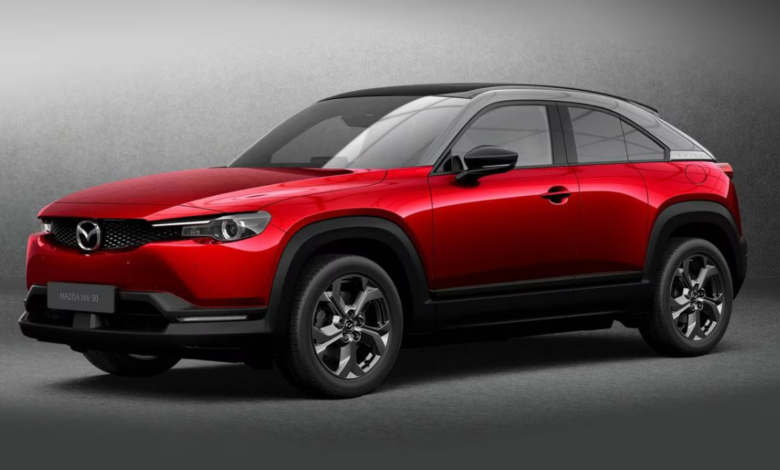
As the first (and only) electric vehicle from the Japanese manufacturer, the Mazda MX-30 EV is back for its second year. The only all-electric vehicle currently available is the MX-30, but a plug-in hybrid CX-90 is on the way. This crossover has a nice appearance, and at 173.3 inches long, it’s about the same size as other electric vehicles that can seat five people. Many features of the gas-powered CX-30 are present in it. Though it has a nice appearance, this E.V. is underwhelming. On our list of the “Best Affordable E.V.s,” it has one of the lowest ratings among E.V.s.
The MX-30 has an unacceptable limitation because it can only go 100 miles on a single charge because of its meagre 35.5 kWh lithium-ion battery. Mazda will continue to market this as an urban vehicle for drivers with low mileage in 2023, and it will only be available in California in two trim levels: basic and Premium Plus. For 2023, there was a minor price increase. The Mazda MX-30 e-Skyactiv R-EV is a plug-in hybrid vehicle that can go up to 52 miles on pure electricity using a 17.8 kWh battery and a 50-litre petrol tank. However, it is limited to usage in Europe.
Its 80.9 kW engine, which generates 200 pound-feet of torque and 143 horsepower, powers the front wheels. That’s less power than its competitors, and it doesn’t accelerate as quickly as typical for an E.V. Its competitors include the Nissan Leaf, Hyundai Kona Electric (which will receive a completely new model in 2024), the soon-to-be-ceased Chevrolet Bolt EV and EUV, and even the smaller Mini Cooper SE. However, most of these vehicles are more efficient than the Mazda.
The MX-30 is available in two trim levels: Premium Plus ($37,120) and Basic E.V. ($34,110, not including a $1,375 destination charge). Both come with an extensive feature list that includes many driver-assist safety systems. It also has less head- and legroom than most of its rivals. Although they don’t always function well, their “freestyle” rear-hinged back doors look interesting. Like an extended cab truck, you must open the front doors first, then the back ones, and shut them sequentially. There are just 30.1 inches of legroom in the back seat once you are in.
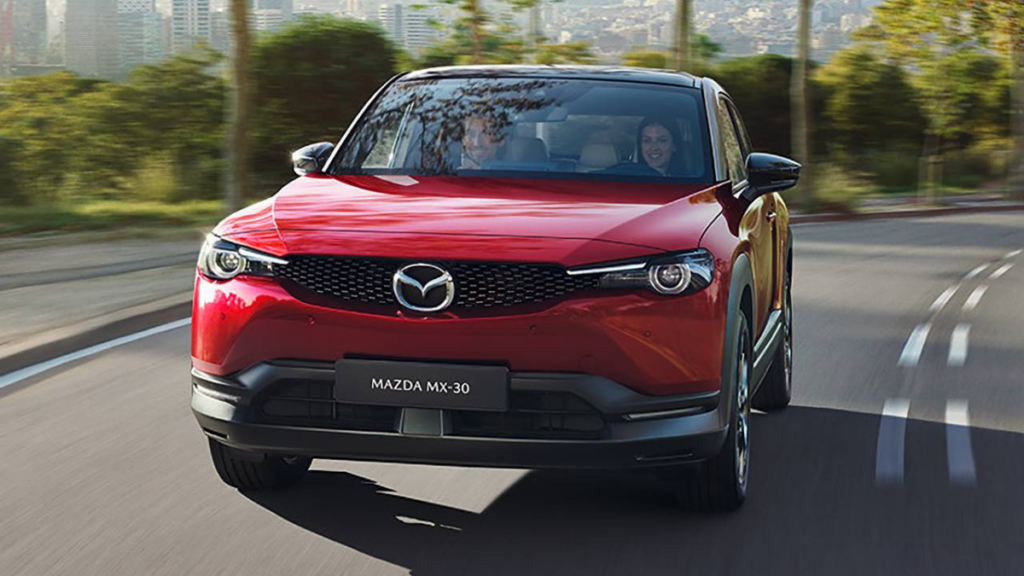
The inside finish is more luxurious than the price implies, with eco-friendly materials like a cork on the “floating” centre console and fabric made of recycled fibres honouring Mazda’s past as a maker of cork gaskets. Some infotainment elements need a joystick and buttons installed on the console, although the climate controls are on a touchscreen next to the electronic shifter. Voice control is another option; it takes some getting accustomed to, but it does the job.
Though there is one benefit, the apparent problem with the automobile keeps coming up: With a 240-volt charger, the compact battery can be recharged in a little over 5 hours, compared to about 10 hours for most competitors. It takes around 36 minutes to fast-charge to 80%. Nevertheless, range anxiety is high, and most drivers don’t want to stop as often as the MX-30 demands. The restricted range of the MX-30 will turn off most customers. Only ardent Mazda enthusiasts who wish to use the car for short commutes and probably as a second (or third) automobile would find the MX-30 appealing.
Performance: Mazda MX-30 EV
It’s enjoyable to drive the MX-30 if you ignore its low range. It’s a smooth, balanced, and adeptly handled vehicle that quickly takes bends. Going as far as with other E.V.s won’t be possible, but the journey there will still be enjoyable.
An 80.9-kilowatt electric motor powers the front wheels of the MX-30. Its 200 pound-feet of torque and 143 horsepower are on the lower end of the competition. The Nissan Leaf S.V. Plus can reach 214 horsepower, compared to 200 in the Chevrolet Bolt EV.
Mazda’s gasoline-powered vehicles feature a technology called G-Vectoring Control for smoother turning, which gradually modifies engine torque to match steering input when the car is steered correctly and has a tight chassis. A variation of this is used on the electric motor of the MX-30, and it works just as well there to refine the driving dynamics.
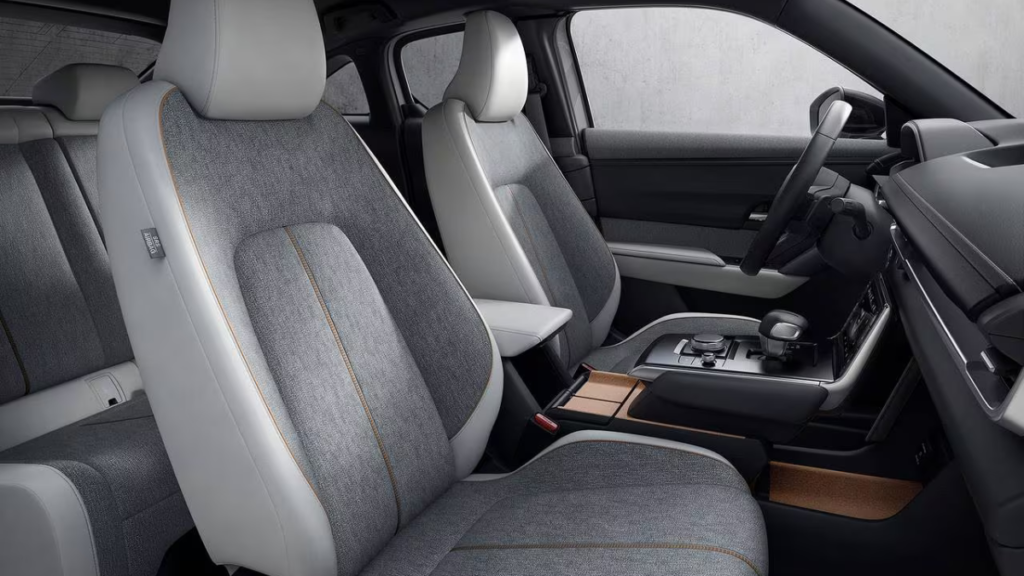
Power Consumption, Charging, and Range:
With its meagre 35.5 kWh lithium-ion battery, the MX-30 has a meagre 100 miles of maximum range. Its 6.6 kW onboard charger recharges the battery on a 240-volt charger in around 5 hours, roughly half the time of its rivals with more extensive ranges. Since most commuters only go thirty miles a day, Mazda uses this as justification for the short battery. However, it doesn’t explain the car’s accompanying range concern. Several rivals provide a range that is more than twice as great.
The MX-30 uses the same amount of energy—37 kWh—per 100 miles as larger electric SUVs, such as the Ford Mustang Mach-E. The combined EPA rating for a gasoline engine is 92 MPGe (98 city and 85 highway).
Among comparable electric competitors, it is the lowest; all of them have a bigger electric motor, higher power, and a far greater range than the MX-30. The Hyundai Kona EV has an efficiency rating of 120 MPGe, compared to 109 MPGe for the Nissan Leaf S.V. The somewhat bigger Bolt EUV gets 115 MPGe, while the Bolt EV from Chevrolet gets 120 MPGe. All of them have ranges that are more than twice as long as the MX-30’s 100 miles, with the Bolt EV having the most extended range at 259 miles. A single charge may get even Mini’s little Cooper SE as far as 114 miles.
Driver assistance and safety:
The National Highway Traffic Safety Administration (NHTSA) gave the MX-30 a five-star (highest) rating, raising it from the previous year. However, the Insurance Institute for Highway Safety (IIHS) hasn’t tested it yet. It is marketed internationally and has high five-star ratings from ANCAP in Australia and NCAP in Europe.
Both trim levels of the MX-30 come equipped with the majority of driver assistance features as standard, such as automatic high-beam headlamps, blind-spot monitoring with rear cross-traffic alert, adaptive cruise control, front and rear emergency braking, lane-departure warning and lane-keep assist, and driver and passenger knee airbags. Upgrades to the upper-level Premium Plus include a 360-degree camera, auto-dimming rearview and driver’s side mirrors, front cross-traffic warning, and blind-spot assist, which helps you steer back into your lane if you try to move over while a car is next to you.
Coziness & Space:Mazda MX-30 EV
The MX-30 has front seats that are supportive and comfy, plus it has recycled fabric inserts as an added advantage. It has the sense of a contemporary, simple living room with plenty of furniture. On both trim levels are heated seats and a power-adjustable driver’s seat; the Premium Plus also has a heated steering wheel.
Although the seats are excellent, the MX-30 may be cramped, particularly in the rear. While rivals have over 40 inches of front headroom, this one only has 38.5 inches. Its 37 inches of back headroom puts it on pace with others, but it’s still the smallest. Compared to its rivals, the front seats provide an average of 41.6 inches of legroom, while the rear only offers 30.1 inches. Its more spacious competitors have back legroom ranging from 33.4 inches in the Kona Electric to 39.2 inches in the Bolt EUV. Once again, there’s a bit of additional back legroom in the Mini.
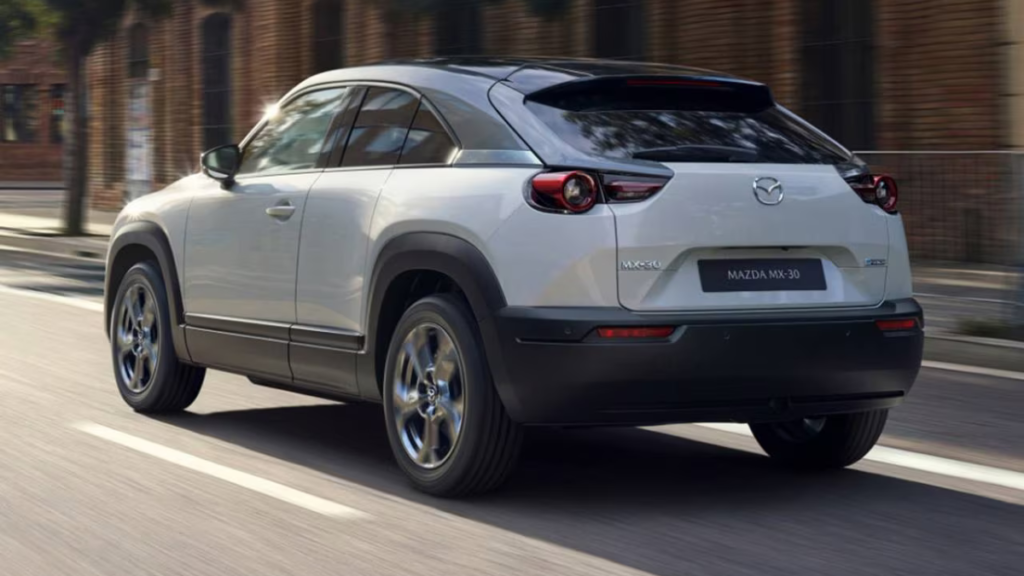
Infotainment: Mazda MX-30 EV
The 8.8-inch infotainment screen on the MX-30 is tucked up against the top of the dash. It is controlled via buttons on the console and a joystick. It might seem sluggish and need many steps for some activities. A touchscreen might make things easier, but it also has voice commands, is simple to use, and is intuitive.
Both trim levels come with two USB ports with Apple CarPlay and Android Auto, but they also need a connection. The eight-speaker Bose audio in the basic trim is replaced with a 12-speaker system, and satellite radio with a complimentary three-month SiriusXM trial is included. The infotainment system supports onboard navigation but needs an S.D. card, which costs $450 at the dealer.
Storage & Cargo Space:
When the back seats are folded down, the MX-30’s load capacity is 21 cubic feet. That is somewhat small compared to most traditional crossover SUV models, but it is comparable to its E.V. rivals. With 16.6 and 19.2 cubic feet, respectively, the Bolt EV and Kona Electric have fewer cubic feet than the Leaf’s 23.6 cubic feet. With the back seat folded down, the Mazda offers up to 36.2 cubic feet of space, much less than the 45.8 cubic feet or 57 cubes in the Bolt EV or Kona.
Its broad hatch opening and relatively low lift-over to raise objects over the bumper make putting goods in the rear simple. There is decent open space on the floating centre console, particularly for electronics, which houses the small-item storage area.
Unfortunately, because the MX-30 is a converted gas car and the electric engine takes up room, there isn’t a front trunk or “frunk.” Even though the extended range version hasn’t yet made it to the United States, Mazda also intended to make space for a gas engine.
Design: Mazda MX-30 EV
The MX-30 looks nice without any attempted futuristic elements or electrical tricks. That might be a result of its foundation being the traditional CX-30. It keeps Mazda’s “Kodo” design language while improving it for the electric vehicle version with new taillights and a smaller front panel that replaces the CX-30’s grille. Though not the most practical, the rear-hinged “freestyle” back doors pay tribute to the rotary-powered Mazda RX-8 sports vehicle and have a unique appearance. Sadly, it necessitates a thick back pillar, which reduces visibility.
The “floating” centre console provides the cabin with a light, airy vibe, making the technological elements appear less conspicuous. The texture and appearance of the cork surfaces set the house apart and honour Mazda’s history of producing cork gaskets.
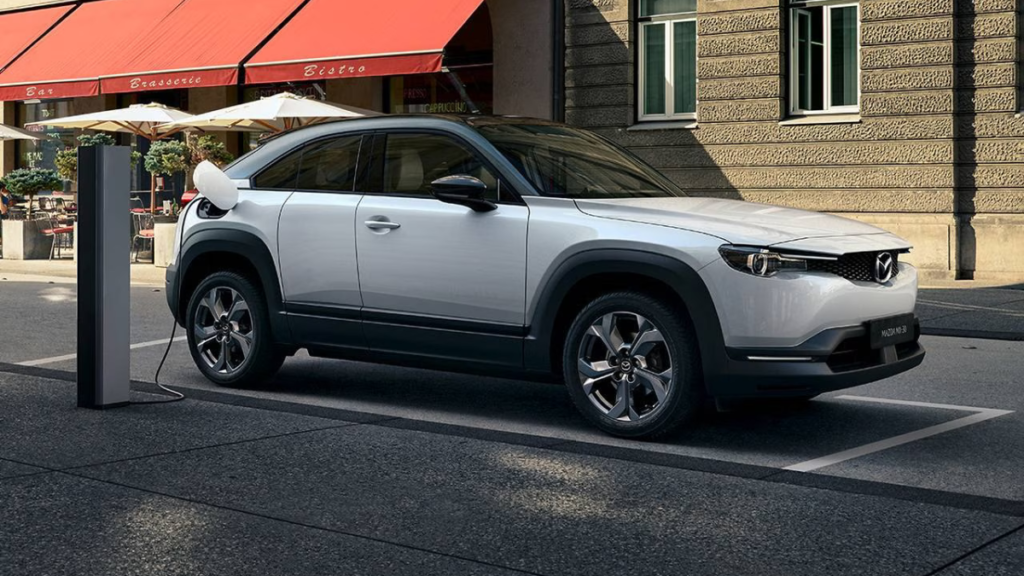
Is the 2023 Mazda MX-30 Worth it?
The MX-30 EV starts at $34,110 without the $1,375 destination charge. The Premium Plus trim costs $37,120. The Mazda is no longer eligible for a $7,500 discount due to changing government standards for an E.V. tax credit. Only dealer accessories like a cargo cover for $175, all-weather floor mats for $125, or a GPS SD card for $450 are available. The extra-charge colors are $595 for Machine Gray Metallic and $895 for Ceramic Metallic.
With options like a sunroof, adaptive headlights, blind-spot monitoring, rain-sensing wipers, and 18-inch alloys, both grades are very well-equipped. A superior audio, blind-spot assistance, an auto-dimming rearview and driver’s side mirror, a heated steering wheel, and satellite radio are included with the $3,010 Premium Plus package.
A $500 ChargePoint credit is included with both trim levels, which may be used to install a 240-volt Level 2 home charger or public charging.
Except for a few entertainment and comfort enhancements, the standard model has almost all the same features, making it the most excellent value option. However, the MX-30 is a bad option if you’re going fully electric due to its limited range and efficiency. Besides the Mini, every E.V. rival provides far more, even if the starting price is somewhat higher. Moreover, prospective E.V. buyers’ access to it is restricted by the asterisk that applies solely to California.
How Much Does Mazda MX-30 Insurance Cost 2023?
The figures may differ since so few MX-30s have been sold, but its insurance prices are comparable to its rivals. An average yearly premium for a female driver in her thirties with a spotless record would be around $2,149. In contrast, the Nissan Leaf costs $2,164, the Hyundai Kona EV costs $1,860, and the Chevrolet Bolt EV costs $2,067.
Mazda MX-30 Generations
First Generation
2022- Present
The MX-30 was first shown in Japan in 2019, but the carmaker did not release it in the United States until 2022. It is the first all-electric car offered by Mazda in the U.S. While the MX-30 is now only available as an electric vehicle with an 80.9-kilowatt electric motor producing 143 horsepower and 200 pound-feet of torque, a mild hybrid variant fueled by gas is also available in some other nations. There was no news on a U.S. version of the range-extending gas engine when it debuted at the Brussels auto show in early 2023. The Mazda MX-30 e-Skyactiv R-EV is a plug-in hybrid vehicle with a 52-mile pure electric range that uses a rotary engine as a generator—a 50-litre petrol tank and a 17.8 kWh lithium-ion battery power the plug-in hybrid variant.
Verdict
In its second year of production, Mazda’s first all-electric car, the 2023 MX-30, is even more annoying. With its meagre 100-mile maximum range, it was a disappointing E.V. debut last year. However, it returned with little modifications, and its availability confined to California highlights Mazda’s electric future. While it isn’t the most expensive among E.V. competitors, at least its price hasn’t increased much. An expanded version was offered only for Europe. Its timeless Mazda style and elegant interior with vibrant colours and thoughtful selections that emphasize sustainability make it look fantastic even now. However, appearances can only do so much. Mazda is aware that this isn’t a competitive E.V. option.




